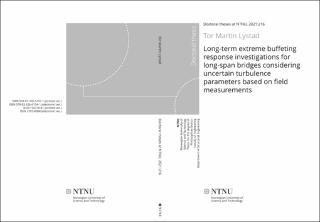| dc.contributor.advisor | Øiseth, Ole Andre | |
| dc.contributor.advisor | Rønnquist, Anders | |
| dc.contributor.author | Lystad, Tor Martin | |
| dc.date.accessioned | 2021-06-15T07:35:09Z | |
| dc.date.available | 2021-06-15T07:35:09Z | |
| dc.date.issued | 2021 | |
| dc.identifier.isbn | 978-82-326-6154-1 | |
| dc.identifier.issn | 2703-8084 | |
| dc.identifier.uri | https://hdl.handle.net/11250/2759450 | |
| dc.description.abstract | When bridges become increasingly longer, the dynamic behavior from wind and waves can dominate the structural load effects. To build better knowledge about the dynamic behavior of long-span bridges subjected to turbulent wind in complex terrain, the Norwegian University of Science and Technology has instrumented the Hardanger Bridge with a full-scale measurement system. The Hardanger Bridge measurement program, along with many full-scale measurement efforts on long-span bridges around the world, has shown a large scatter in the measured buffeting response when plotted against the mean wind velocity.
The wind field information defining the basis for design of such bridges, is fundamental to achieve a reliable extreme load definition. In this thesis, the traditional methods for wind field measurements are investigated by comparing the in-situ mast measurements and terrain model wind tunnel tests performed before the design of the Hardanger Bridge with wind measurements along the span of the current bridge.
The full long-term method is recognized as the most accurate way to predict the extreme response of a structure subjected to stochastic dynamic loads. However, in current design practice for buffeting action of long-span bridges this has not yet become the standard way to estimate the extreme responses. In the work presented herein, the long-term extreme buffeting response of the Hardanger Bridge is investigated, considering the turbulence variability effects and the short-term extreme response uncertainty. The findings show that both the turbulence variability and the short-term extreme response uncertainty is very important for the design response of the Hardanger Bridge girder.
Finally, a new algorithm based on Gaussian process regression for long-term extreme response calculations is proposed, exhibiting several attractive qualities in terms of accuracy and computational efficiency. | en_US |
| dc.language.iso | eng | en_US |
| dc.publisher | NTNU | en_US |
| dc.relation.ispartofseries | Doctoral theses at NTNU;2021:216 | |
| dc.relation.haspart | Paper 1: Lystad, Tor Martin; Fenerci, Aksel; Øiseth, Ole. Evaluation of mast measurements and wind tunnel terrain models to describe spatially variable wind field characteristics for long-span bridge design. Journal of Wind Engineering and Industrial Aerodynamics 2018 ;Volum 179. s. 558-573 https://doi.org/10.1016/j.jweia.2018.06.021 | en_US |
| dc.relation.haspart | Paper 2: Lystad, Tor Martin; Fenerci, Aksel; Øiseth, Ole Andre. Aerodynamic Effect of Non-uniform Wind Profiles for Long-Span Bridges. I: Proceedings of the XV Conference of the Italian Association for Wind Engineering. Springer 2019 ISBN 978-3-030-12815-9. s. 427-439 https://doi.org/10.1007/978-3-030-12815-9_34 | en_US |
| dc.relation.haspart | Paper 3: Lystad, Tor Martin; Fenerci, Aksel; Øiseth, Ole Andre. Buffeting response of long-span bridges considering uncertain turbulence parameters using the environmental contour method. Engineering structures 2020 ;Volum 213. s. 1-17 https://doi.org/10.1016/j.engstruct.2020.110575
This is an open access article under the CC BY license (http://creativecommons.org/licenses/by/4.0/). | en_US |
| dc.relation.haspart | Paper 4: Lystad TM, Fenerci A, Øiseth O. Long-term extreme buffeting response of cable-supported bridges with uncertain turbulence parameters. Engineering Structures 2021;236:112126.
https://doi.org/10.1016/j.engstruct.2021.112126
This is an open access article under the CC BY license (http://creativecommons.org/licenses/by/4.0/). | en_US |
| dc.relation.haspart | Paper 5: Lystad TM, Fenerci A, Øiseth O. Full long-term extreme structural response with sequential Gaussian process surrogate modelling. | en_US |
| dc.title | Long-term extreme buffeting response investigations for longspan bridges considering uncertain turbulence parameters based on field measurements | en_US |
| dc.type | Doctoral thesis | en_US |
| dc.subject.nsi | VDP::Technology: 500::Building technology: 530::Construction technology: 533 | en_US |

